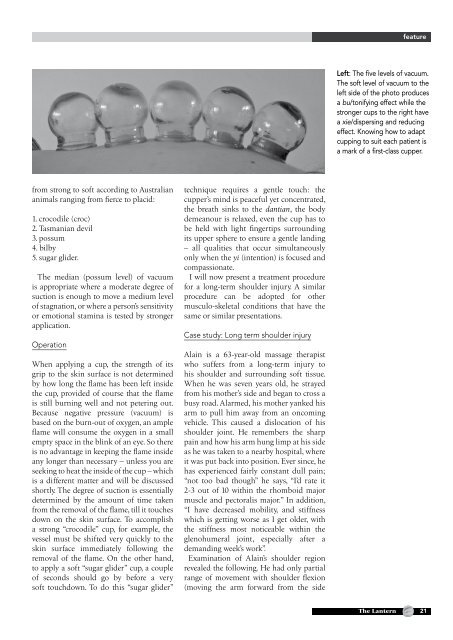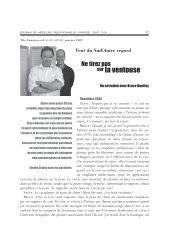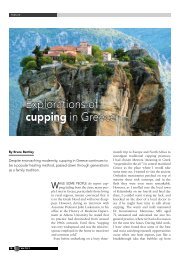Cupping Deficiency - Australian School of Traditional Thai Massage
Cupping Deficiency - Australian School of Traditional Thai Massage
Cupping Deficiency - Australian School of Traditional Thai Massage
Create successful ePaper yourself
Turn your PDF publications into a flip-book with our unique Google optimized e-Paper software.
from strong to s<strong>of</strong>t according to <strong>Australian</strong><br />
animals ranging from fierce to placid:<br />
1. crocodile (croc)<br />
2. Tasmanian devil<br />
3. possum<br />
4. bilby<br />
5. sugar glider.<br />
The median (possum level) <strong>of</strong> vacuum<br />
is appropriate where a moderate degree <strong>of</strong><br />
suction is enough to move a medium level<br />
<strong>of</strong> stagnation, or where a person’s sensitivity<br />
or emotional stamina is tested by stronger<br />
application.<br />
Operation<br />
When applying a cup, the strength <strong>of</strong> its<br />
grip to the skin surface is not determined<br />
by how long the flame has been left inside<br />
the cup, provided <strong>of</strong> course that the flame<br />
is still burning well and not petering out.<br />
Because negative pressure (vacuum) is<br />
based on the burn-out <strong>of</strong> oxygen, an ample<br />
flame will consume the oxygen in a small<br />
empty space in the blink <strong>of</strong> an eye. So there<br />
is no advantage in keeping the flame inside<br />
any longer than necessary – unless you are<br />
seeking to heat the inside <strong>of</strong> the cup – which<br />
is a different matter and will be discussed<br />
shortly. The degree <strong>of</strong> suction is essentially<br />
determined by the amount <strong>of</strong> time taken<br />
from the removal <strong>of</strong> the flame, till it touches<br />
down on the skin surface. To accomplish<br />
a strong “crocodile” cup, for example, the<br />
vessel must be shifted very quickly to the<br />
skin surface immediately following the<br />
removal <strong>of</strong> the flame. On the other hand,<br />
to apply a s<strong>of</strong>t “sugar glider” cup, a couple<br />
<strong>of</strong> seconds should go by before a very<br />
s<strong>of</strong>t touchdown. To do this “sugar glider”<br />
technique requires a gentle touch: the<br />
cupper’s mind is peaceful yet concentrated,<br />
the breath sinks to the dantian, the body<br />
demeanour is relaxed, even the cup has to<br />
be held with light fingertips surrounding<br />
its upper sphere to ensure a gentle landing<br />
– all qualities that occur simultaneously<br />
only when the yi (intention) is focused and<br />
compassionate.<br />
I will now present a treatment procedure<br />
for a long-term shoulder injury. A similar<br />
procedure can be adopted for other<br />
musculo-skeletal conditions that have the<br />
same or similar presentations.<br />
Case study: Long term shoulder injury<br />
Alain is a 63-year-old massage therapist<br />
who suffers from a long-term injury to<br />
his shoulder and surrounding s<strong>of</strong>t tissue.<br />
When he was seven years old, he strayed<br />
from his mother’s side and began to cross a<br />
busy road. Alarmed, his mother yanked his<br />
arm to pull him away from an oncoming<br />
vehicle. This caused a dislocation <strong>of</strong> his<br />
shoulder joint. He remembers the sharp<br />
pain and how his arm hung limp at his side<br />
as he was taken to a nearby hospital, where<br />
it was put back into position. Ever since, he<br />
has experienced fairly constant dull pain;<br />
“not too bad though” he says, “I’d rate it<br />
2-3 out <strong>of</strong> 10 within the rhomboid major<br />
muscle and pectoralis major.” In addition,<br />
“I have decreased mobility, and stiffness<br />
which is getting worse as I get older, with<br />
the stiffness most noticeable within the<br />
glenohumeral joint, especially after a<br />
demanding week’s work”.<br />
Examination <strong>of</strong> Alain’s shoulder region<br />
revealed the following. He had only partial<br />
range <strong>of</strong> movement with shoulder flexion<br />
(moving the arm forward from the side<br />
feature<br />
Left: The five levels <strong>of</strong> vacuum.<br />
The s<strong>of</strong>t level <strong>of</strong> vacuum to the<br />
left side <strong>of</strong> the photo produces<br />
a bu/tonifying effect while the<br />
stronger cups to the right have<br />
a xie/dispersing and reducing<br />
effect. Knowing how to adapt<br />
cupping to suit each patient is<br />
a mark <strong>of</strong> a first-class cupper.<br />
The Lantern 21




